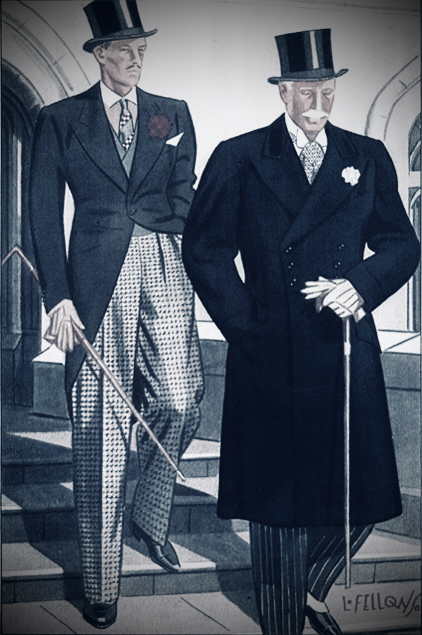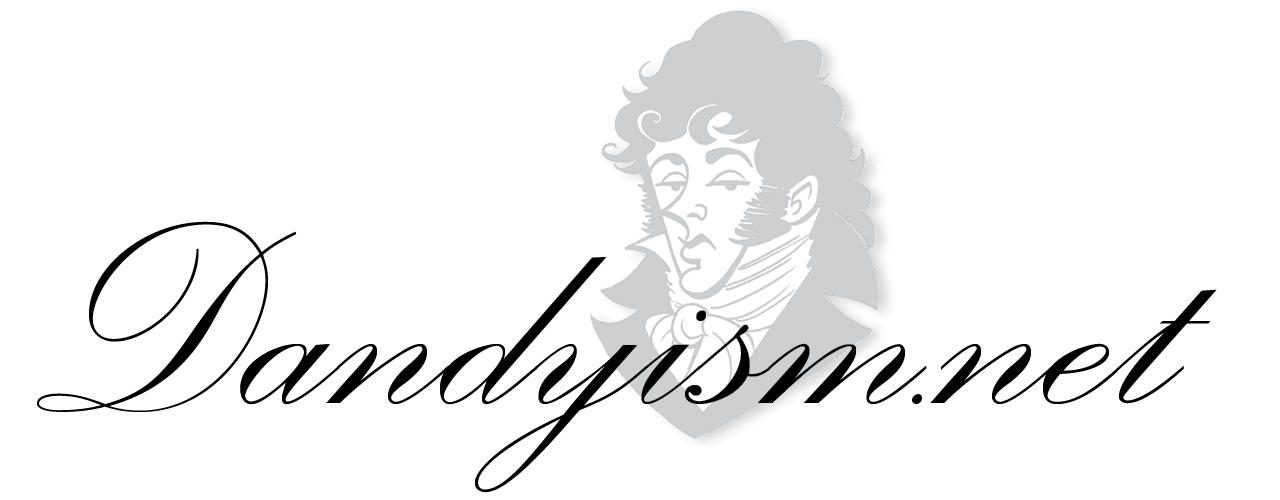 In the spring of 1934, a gentleman with a neatly trimmed mustache casts an eye in the direction of the door to an office waiting room, temporarily distracting him from the copy of Esquire he’s just picked up. Is he waiting for a stockbroker? A dentist? A divorce lawyer?
In the spring of 1934, a gentleman with a neatly trimmed mustache casts an eye in the direction of the door to an office waiting room, temporarily distracting him from the copy of Esquire he’s just picked up. Is he waiting for a stockbroker? A dentist? A divorce lawyer?
We can tell he’ a man of means and sophistication from his outfit. He’s sporting a lightweight double-breasted suit in a strong check pattern. His blue shirt has a starched white collar and cuffs, and his Guards tie is finished with a four-in-hand knot. His blue pocket square is a few shades paler than his shirt, and matches his socks. His shoes are brown cap-toe balmorals. A gray homburg and rattan cane have been casually placed on an adjoining chair. Wearing a checked suit in town is something nearly unheard of, but this man pulls it off smashingly. We know he’s confident in his clothes and his world, because the world he inhabits is the creation of an artist who signs himself L. Fellows.
And you can be sure that in the months after this illustration appeared, far more checked double-breasted suits were seen on city sidewalks.
If you’ve ever cracked open an old Apparel Arts magazine or vintage Esquire from the ’30s to the ’50s, you’ve seen the distinctive fashion art of Laurence Fellows. But who was this Fellows fellow, anyway?
Fellows was born in Ardmore, Pennsylvania in 1885. He was trained in illustration at the Pennsylvania Academy of Art, and honed his trademark “continental” style studying in England and France. But the real story begins when he returned to the States in the early 1910s and burst on the scene as an eager and talented young artist.
Fellows found work contributing to satirical magazines like Life and Leslie’s, and his European-influenced style was fresh and new, reflecting the sleekness and stylization that led to Art Deco. His work was so fresh, in fact, that he found many of his better-known contemporaries, including John Held, Jr. and Ralph Barton, were adapting his stylistic elements for their own use.
Fellows’ style during this period was very mannered and graphic, with thin black outlines enclosing flat expanses of tone and compositions that emphasized graphic weight and balance over fussy illustrative detail. His bread and butter throughout the 1920s was his work for the Kelly-Springfield Tire company. He brought an idea to the Kelly advertising manager for a series of magazine ads featuring “smart cars and smart types of people.” It was the beginning of an assignment that lasted for nearly a decade. The ads are still smart and fashionable today (and becoming collectible, by the way).
But it was in the 1930s that Fellows found the niche that would shape the lives of dandies for the next 80 years: fashion illustration. Though he contributed to Vanity Fair and The American Magazine, among other publications, it was men’s fashion where he was most in demand, and Apparel Arts, aimed at the tailoring trade, and Esquire were his showcases.
Fellows’ technique as a fashion illustrator was more painterly and detailed than his earlier commercial work. The man could draw fabric, plain and simple. His fabric had weight, heft, drape, texture, and sheen. His flannels, worsteds, tweeds, and linens, his barathea and velvet and twill were all fabulous.
He also defined a very specific, very masculine world. Unlike today’s fashion magazines, Apparel Arts didn’t dictate fashion trends by using underfed models in unwearable suits. It showed what was already being worn by the well-heeled, trend-setting folk. Fellows’ genius as an illustrator lay in his ability to depict them in their everyday activities. Whether they were traveling the world, hosting dinner parties, hunting grouse, or just lounging around the penthouse or club, Fellows somehow made their rarified universe accessible. Ordinary folks could look at the illustrations and say, “I could wear that.”
Rather than looking overdressed and stuffy, or merely human shapes on which to hang clothes, Fellows’ subjects are men for whom dressing splendidly comes naturally. They’re having a good time, smiling, and enjoying themselves in their relaxed, party-filled sphere, and all of them are illustrations of casual, well-tailored elegance.
Laurence Fellows died in 1964, and in 2009 was named to the Society of Illustrators Hall of Fame. His immortality in the world of men’s fashion is assured simply because he had the ability to illustrate real men in their real lives and make those lives ones we all want to live. — BILL THOMPSON

Great post, great pictures. Well done, Thompson.
Nicely done. Thank you.
Great story, Mr. Thompson. Thank you for furthering my education and providing me with a break from hearing about the markets.
I not only appreciate the (characteristically languid) efforts to update the site, but the fact that the wait is worthwhile, also. Happy New Year and well done to Mr. Thompson
Regarding the terminal illustration: when did golfing fellows go so decidedly and drastically wrong? These chaps look jolly decent, but the contemporary lot of vulgar professionals have inspired the average club golfer to go about in manmade fibres! For shame.
Well done Thompson. Not to sound demanding, but give us more. You’re a guy who can write. Keep it up.
Finally some answers to the mystery of L. Fellows. Thank you, Mr Thompson!
Hi… First of all, congratulations for this blog: is wonderful. I’m absoluty fascinated by Laurence Fellow’s art. Somebody knows a book with a compilation with their images… Thank you for your help!
The Laurence Fellows Illustration is great,they show the gentleman very well
Fantastic article about Fellows. It inspired me to write another Laurence Fellows article that focuses more on his different drawing styles and looks also to the 1940’s.